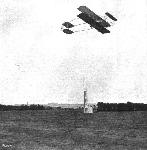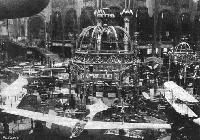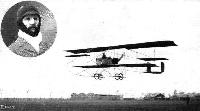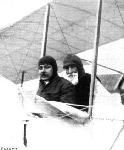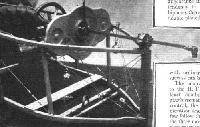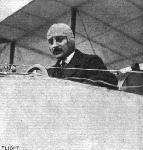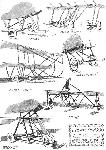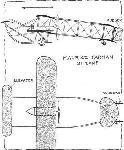J.Davilla, A.Soltan French Aircraft of the First World War (Flying Machines)
Maurice Farman Pre-War Planes
<...>
2. M.F.2 (1911) - 70-hp Renault 8B; reconnaissance plane entered in 1911 concours militaire.
<...>
Показать полностью
L.Opdyke French Aeroplanes Before the Great War (Schiffer)
Deleted by request of (c)Schiffer Publishing
Type Coupe Michelin: Resembling a simplified development of the MF 1, this handsome aeroplane flew in March 1910 and towards the end of the year in the Coupe Michelin, showing what became for a while the Maurice Farman trademark: a forward elevator with curved tips mounted on large gracefully curved outriggers, 2 oval tailplanes and 2 rudders. 2 wheels supported the aircraft, with 2 small tailwheels at the rear. It first had equal-span wings with curved tips and side-curtains near the ends; then the upper wing was lengthened and the side-curtains removed. Ailerons were hung from the lower wings.
(Span: 11 m; length: 12.75 m; wing area: 50 sqm; loaded weight: 500 kg; speed: 80 kmh; 50 hp Renault V8)
MF ? This handsome staggered biplane appeared at the 1911 Paris Salon. Ailerons were set at the top wing trailing edge.
Показать полностью
Журнал Flight
Flight, October 22, 1910
IMPRESSIONS OF THE PARIS SHOW.
By OISEAU.
<...>
M. Maurice Farman has discarded the vertical planes once fitted by him, and the skids on his machine are now continued until they join the elevator, as on the Sommer.
<...>
Flight, November 5, 1910
FOREIGN AVIATION NEWS.
Flying for a Quarter of a Day.
WITH the approach of the end of the year and the closing of the annual competition for the Michelin Cup, the competition for the world's duration record suddenly becomes active. We mentioned last week that Tabuteau had flown over to Etampes from Buc in order to spy out the land with a view to attacking the world's records. Everything was ready on Friday, and at 9 o'clock in the morning he started off on his Maurice Farman biplane. Around and round his course he flew for 6h. 1m. 35s., when he landed after having covered 465 kiloms. (290 miles), about as far as from London to Carlisle. In the course of this trip his 8-cyl. Renault consumed 190 litres of petrol, and 20 litres of lubricating oil. The old world's record was that of Olieslaegers, who at Rheims flew 244.309 miles in 5h. 3m. 5 1/5s.
Flight, November 19, 1910
AEROPLANE SILHOUETTES FROM THE PARIS SHOW.
THE MAURICE FARMAN BIPLANE.
FRENCH-BUILT biplane with forward elevator working in unison with elevator on tail. Planes double-surfaced throughout. All control wires duplicated. Similar in type to the Henry Farman biplane. Holds at the present time world's record for duration of flight. Maurice Tabuteau on an M. Farman biplane with Renault motor flew at Etamps for 6h. 1m. 35s., covering 465 kiloms.
General dimensions. - Bearing surface, 50 square metres; length overall, 12745 metres; width, 11 metres.
Seating capacity. - Two, one behind the other.
Engine. - Renault, 8 cylinders, V type, air-cooled of 60-h.p.; weight, 170 kilogs. Propeller is mounted on the cam-shaft. Any motor fitted.
Propeller. - One Chauviere Integrate of two branches, 2.75 metres to 3 metres in diameter; pitch, 1.60 metres; normal revolutions, 900. Situated behind main planes.
Chassis and skids. - The two skids are continued forward and upward until they join the front elevating plane. Two wheels are fitted, with spring suspension, to the skids, and are joined by a light axle.
Tail. - Biplane tail having two rudders hinged to the rear struts of the cellule. Elevators are attached to the trailing edges of both tail planes, and are connected with and operate simultaneously with the front elevator.
Lateral stability. - By ailerons fitted to the trailing edges of both the upper and lower planes.
Weight. - Without motor, 250 kilogs.
Speed. - About 80 kiloms. an hour.
System of control. - By a wheel at the end of a horizontal shaft, moving in a sleeve, and mounted on ball-bearings. Pulling the wheel elevates the machine; pushing depresses the elevator. Rotation to the left depresses the right ailerons, and similarly rotation to the right affects the left ailerons. Foot pedals control the rudders.
Price. - Without motor, 14,000 francs; with 60-h.p. Renault, 28,000 francs.
Flight, January 7, 1911
FRENCH MICHELIN CUP.
JUST as was the case in England, the closing days of the competition for the International Michelin Cup in France provided quite a deal of excitement. The Cup is awarded for the longest distance flown without a stop. On the last day of the year no less than five French aviators set out to try and beat the record made on the previous day by Tabuteau, but without success, and the latter's record of 584.935 kiloms. in 7h. 48m. 31 3/5s. therefore secured to him the right to hold the Cup for the ensuing year.
Real Contest Begins.
On the 29th ult. the attempts commenced in real earnest. At Buc, Tabuteau set out to regain the world's record on his Maurice Farman machine, but after he had traversed a distance of 400 kiloms. he was compelled to come down by the thick mist. His time for 390 kiloms. was 5h. 12m. 49 1/5s. At Etampes Henry Farman also made another attempt to place the record to his credit. Starting off at eight o'clock in the morning, he was flying until half past ten, by which time a distance of about 150 kiloms. had been covered, his speed being about 63 kiloms. an hour. Then, in view of the way in which the rain, which had been falling for some time, was freezing on the upper plane of his machine, he decided that it was useless to continue, and came down. On landing, it was found that the ice which had gathered on the plane was very little short of 80 kilogs. in weight.
The Winning Flights and New Records.
As we have mentioned above, the winning flight for the Cup was made on the 30th ult. at Buc. At twenty minutes to eight Tabuteau started off in very cold but fine weather, determined to remain in the air until he had beaten all records. He had been circling round and round the course for nearly an hour when his friend Renaux also took the air. He, however, only continued for about five hours, when finding that Tabuteau had apparently got his task well in hand, he decided to come down. He did not travel quite so fast as Tabuteau, his time for 350 kiloms. being 4h. 56m. 43 1/5s. Tabuteau continued on his course until twenty minutes past three, when having ascertained that he had well beaten the distance record, he decided to descend, although he could have gone on for an hour or so more. He had then been in the air 7h. 48m. 31 3/5s., and had covered 584.935 kiloms. (365 miles), beating the previous best record by Legagneux by just on 40 miles. The flight was timed by Gaudichard, and officially observed, on behalf of the Aero Club of France, by M. Fournier. In the course of his flight, Tabuteau set up a new record for 500 kiloms. in 6h. 41m. 1 3/5 s., and also a new record for 7 hrs. of 522.935 kiloms., while his time for 550 kiloms. was 7h. 19m. 41 1/5 s.
On the same day Thomas made a fresh attempt on his Antoinette monoplane at Mourmelon. He, however, was flying very low, and after being in the air for 3h. 5m. 4s., one of the wings of his machine touched the ground in making a turn, and the official observers were obliged to count that as the termination of the flight. By that time a distance of 262 kiloms. had been covered, and the world's record for 250 kiloms. beaten.
Flight, March 11, 1911
RENAUX WINS THE MICHELIN PUY DE DOME PRIZE.
AFTER being open for just on three years, the L4,000 prize offered by M. Michelin for a passenger flight from Paris 10 the top of the Puy de Dome has been won. The conditions imposed called for considerable daring, and M. Michelin himself, as noted in recent issues of FLIGHT, seems to have come to the conclusion that they might lead to an aviator taking unnecessary risks in order to secure the prize. Fortunately, however, as it has turned out, the winning flight has been made almost without incident. For some time M. Eugene Renaux has been practising on a Maurice Farman biplane at Buc, with a view to annexing the reward. On Tuesday morning, conditions being specially favourable, he determined to take his chance. Accompanied by M. Senouque, M. Renaux made his start from Buc at five minutes to nine, making direct for St. Cloud, the official starting point. Having there crossed the imaginary starting line, he headed south, and passing over Issy continued on by way of Montargis and Cosne to Nevers, where a stop of a quarter of an hour was made at the Peuplier aerodrome for replenishment. On restarting the aviators steered for Moulins and so on to St. Pouscain and Gannat. At 2h. 23m. 20s., to be precise, the aeroplane landed on the restricted plateau at the top of the Puy de Dome, 1,600 metres (4,813 feet) high, having first circled round the Cathedral Tower at Clermont-Ferrand, in accordance with the requirements of the regulations. All traffic and business in the town was stopped as the aeroplane approached near its goal, and the spectators waited with breathless excitement until the landing had been safely effected when unrestricted enthusiasm was indulged in. The aeroplane was timed to cross the ground of the Aero Club of France at 9h. 12m. 34s., so that it will be seen that the time for the trip of 350 kiloms. was 5h. 20m. 46s., while the maximum time allowed under the regulations was 6 hours. It is interesting to note some of the times at which various points were passed. For instance, the aviators were sighted at Juvisy at 9.28, Montargis, where the machine caught up and passed an express train, at 10.18, Gien at 10.58, while Nevers was reached at 11.53.
The restart took place at 12h. 7m. 37s., and Moulins was passed at 1.20. It will be remembered that only two previous attempts have been made to win this prize, one by Weymann, who lost his way, and the other by the brothers Morane, who met with a serious accident.
Flight, May 13, 1911.
FOREIGN AVIATION NEWS.
Maurice Farman takes his Father for a Cross-country Trip.
USING one of his military type biplanes, Mr. Maurice Farman carried his father from Buc to Etampes on the 5th inst. and returned with him to Buc on the following day. The distance via Rambouillet is 80 kiloms., and on the outward journey the time occupied was one minute over the hour, while when returning an hour and a half was necessary for the trip, but then the aviators had to tight against a variable breeze which at times was blowing at 12 metres a second. On the 4th Henry Farman was carrying his brother Dick at Mourmelon.
Flight, March 25, 1911
AEROPLANES.
Farman - On the stand of the Aeroplane Supply Co., who are the English agents for Messrs. Farman Freres, will be found one of the latest military passenger type of Farman biplanes. This machine is a duplicate of that which holds the world's record for time in the air, i.e., 8 hrs. 12 mins,, when a distance of 380 miles was covered before coming to earth. The machine is beautifully finished and an interesting feature is that the pilot's seat is covered in similar to the body of a racing motor car, which shelters the pilot from the wind and lessens body resistance. The machine is fitted with a 60-h.p. Renault engine. We understand that the Aeroplane Supply Company are giving passenger flights on Farman aeroplanes at Hendon during the course of the Show.
Показать полностью




